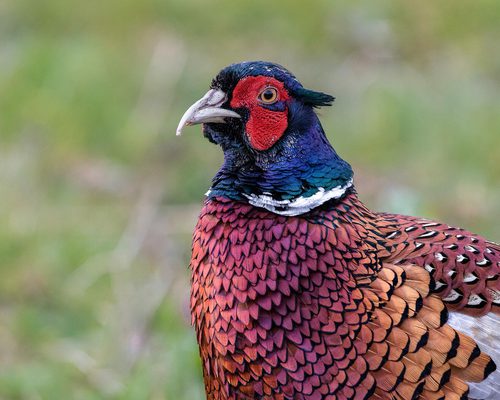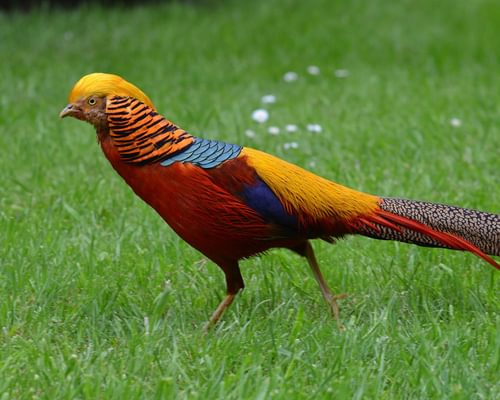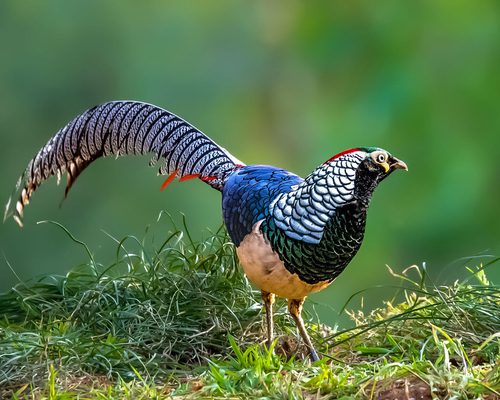Reeves's Pheasant
VulnerableSyrmaticus reevesii
Visual Identification
Appearance
The Reeves's Pheasant is a striking bird, notable for its extremely long tail feathers in males, which can reach up to 1.8 meters, longer than any other pheasant. Males display a golden-brown body with distinct black-and-white markings, a white crown, and a black-and-white barred tail.
Females are smaller and less colourful, with mottled brown plumage and shorter tails. Both sexes have bare red facial skin, grey legs, and a greenish-grey hooked beak. Males also have short spurs on their feet, which females lack.
Juveniles are mostly the same as females but have lighter forenecks and whitish-streaking on their pale brown breasts. Young males are relatively quick to get the pattern on their tails.
Size
Length
100cm to 210cm
Wingspan
80cm to 90cm
Weight
1000g to 1.7kg
Habitat and Distribution
Habitats
Woodland
Garden
Wetland
Coastal
Urban
Farmland
Grassland
Desert
Tundra
Rainforest
Mountain
Savanna
Distribution
Reeves's Pheasants are endemic to central China, inhabiting temperate mixed forests with dense undergrowth. They prefer areas with a mix of coniferous and broadleaf trees, often in mountainous regions.
Their range extends across several Chinese provinces, including Sichuan, Hubei, and Guizhou. These birds are non-migratory, maintaining their territories year-round within suitable habitat areas.
They have been introduced into the United Kingdom, France and the Czech Republic, where small breeding populations have been established, mainly in lowland forests and occasionally farmland.
Elevation Range
Up to 2,600 meters
Climate zones
Temperate, Subtropical
Distribution Map
This map gives you a rough idea of where you might spot a Reeves's Pheasant. The coloured areas show countries where these birds have been seen.
A few things to keep in mind:
- Birds might not be everywhere in the coloured areas, for example, they may be present around the coast of that country
- Where birds live can change with seasons and available food
- This map is quite simple - it doesn't show exact locations
We're working on making our maps even better! Soon, we hope to show you:
- More detailed maps for bigger countries, including state and region
- How birds move around during different seasons
Distribution by Region
Behaviour and Ecology
Bird Attributes
This feature is in beta. We'd love your feedback to improve it!
Share your thoughtsBird Attributes Explained
Our bird attributes system rates various aspects of a bird's capabilities on a scale of 0-100, based on data from field observations, scientific studies, and expert knowledge.
Attribute Categories:
- Agility: Manoeuvrability, speed, and grace in flight or movement.
- Strength: Physical power, often correlating with size and hunting abilities.
- Adaptability: Ability to thrive in various environments or changing conditions.
- Aggressiveness: Territorial behaviour and assertiveness, particularly during breeding seasons.
- Endurance: Stamina, often seen in migration patterns or foraging behaviours.
Understanding the Ratings:
- 0-20: Very Low
- 21-40: Low
- 41-60: Average
- 61-80: High
- 81-100: Very High
Remember, these attributes are relative to other bird species and don't necessarily indicate superiority.
Hover over the icon next to each attribute for more information.
Tap the icon next to each attribute for more information.
Agility
Reflects the bird's manoeuvrability, speed, and grace in flight or movement.
The Reeves's Pheasant demonstrates remarkable agility, particularly in its ability to run swiftly through dense undergrowth. Their capacity to reach speeds of up to 40 km/h (around 25 mph) when threatened indicates exceptional manoeuvrability and quick reflexes.
Strength
Indicates the bird's physical power, often correlating with size and hunting abilities.
While not exceptionally strong compared to larger birds of prey, Reeves's Pheasants possess adequate strength for their size. Their ability to scratch and forage effectively on the forest floor suggests decent muscular power in their legs and feet.
Adaptability
Represents the bird's ability to thrive in various environments or changing conditions.
These pheasants show good adaptability in their omnivorous diet and ability to thrive in mixed forest habitats. However, their vulnerability to habitat loss suggests some limitations in adapting to significant environmental changes.
Aggressiveness
Measures the bird's territorial behaviour and assertiveness, particularly during breeding seasons.
Reeves's Pheasants are generally shy and elusive, preferring to flee rather than confront threats. Males display increased territorial behaviour during breeding season, but overall, they are not particularly aggressive birds.
Endurance
Reflects the bird's stamina, often seen in migration patterns or foraging behaviours.
The Reeves's Pheasant demonstrates good endurance, particularly in its ability to maintain swift running speeds when threatened. Their non-migratory nature and capacity to forage extensively also suggest decent stamina for daily activities.
Diet
Reeves's Pheasants are omnivorous, with a diet consisting primarily of plant matter such as seeds, berries, and leaves. They also consume insects, worms, and small invertebrates.
These birds often forage on the forest floor, using their strong feet to scratch and uncover food items.
They will often feed in small groups of up to 10 or more closely related birds. In Europe, this is usually in unisexual groups and in China mix-sexed groups. This occurs more frequently during the winter and mainly with females and juveniles.
Behaviour
Reeves's Pheasants are generally shy and elusive, preferring to run rather than fly when disturbed. They are often seen foraging on the ground in small groups, scratching the leaf litter for food.
During the breeding season, males become territorial and perform elaborate courtship displays, fanning their long tails to attract females.
Vocalisation
Reeves's Pheasants have a distinctive vocal repertoire. Males produce a loud, harsh 'kworr-kworr' call during the breeding season, often heard at dawn and dusk.
When alarmed, both sexes may emit a sharp, piercing 'kee-kee' sound. Females also make soft clucking noises to communicate with their chicks.
Nesting & Breeding
The breeding season for Reeves's Pheasants typically begins in April and extends through June. Males establish territories and perform elaborate courtship displays to attract females, often involving wing-flapping and tail-fanning.
Females construct nests on the ground, usually hidden in dense vegetation. The nest is a shallow scrape lined with leaves and grass. A clutch typically consists of 7-14 eggs, pale buff with fine brown speckles.
Incubation lasts about 24-25 days, carried out solely by the female. Chicks are precocial and can leave the nest shortly after hatching but remain with the mother for several weeks as they learn to forage.
Lifespan
The Reeves's Pheasant typically lives for 9 years, with a maximum recorded lifespan of 9.2 years.
Like all birds, lifespan can be affected by factors including predation, habitat quality, disease, and access to food sources.
Conservation and Status
Global Conservation Status
Reeves's Pheasant is classified as Vulnerable due to habitat loss and fragmentation. Deforestation and conversion of land for agriculture pose significant threats.
Conservation efforts focus on habitat protection and captive breeding programs to support wild populations.
Birdwatching Tips
- Look for Reeves's Pheasants in the dense undergrowth of mixed forests
- Listen for their distinctive loud, harsh call, especially during breeding season
- Be patient and quiet, as these birds are easily startled
- Visit protected areas in central China for the best chances of spotting them
- Use binoculars to spot their long tails among the foliage
Additional Information
Quick Facts
Other names:
Reeves' Pheasant
Family:
PhasianidaePredators
Main predators of Reeves's Pheasants include large raptors such as golden eagles, as well as terrestrial predators like foxes, wild cats, and martens.
Did You Know?
- The Reeves's Pheasant holds the record for the longest natural tail feathers of any bird species.
- These pheasants can run at speeds up to 40 km/h (around 25 mph) when threatened.
- They were named after John Reeves, a British naturalist who first introduced the species to Europe in the 1830s.
- Historically these birds were illegally hunted for their tail feathers for use in Peking Opera costumes.
Was this bird profile helpful?
Your feedback helps us improve our content
Thanks for your feedback!
Your input helps us improve our content.
Community Experience
Community Ratings
No ratings yet - be the first to rate this bird!
Latest Community Reviews
No reviews yet
Sign in to be the first to review
Community Reviews
Create Your Free Account Welcome Back!
Join our community to rate birds and share your experiences. Creating an account is completely free and only takes a minute. Sign in to your account to rate birds and share your experiences with our community.
Your information is secure and will never be shared.
By creating an account, you agree to our Privacy Policy.
Similar Birds
References
- 2 3 4
website: BirdLife International. 2018. Syrmaticus reevesii. The IUCN Red List of Threatened Species 2018: e.T22679346A131873938.
View source - 1
book, 1990: Caleb Finch, Longevity, Senescence, and the Genome


